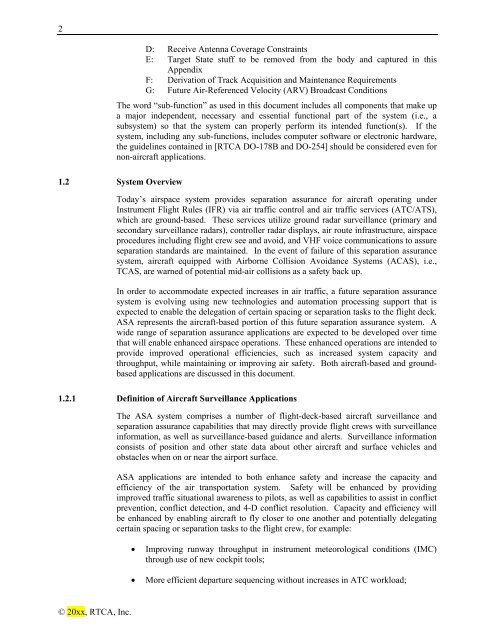Minimum Aviation System Performance Standards for Aircraft ...
Minimum Aviation System Performance Standards for Aircraft ...
Minimum Aviation System Performance Standards for Aircraft ...
Create successful ePaper yourself
Turn your PDF publications into a flip-book with our unique Google optimized e-Paper software.
2<br />
D: Receive Antenna Coverage Constraints<br />
E: Target State stuff to be removed from the body and captured in this<br />
Appendix<br />
F: Derivation of Track Acquisition and Maintenance Requirements<br />
G: Future Air-Referenced Velocity (ARV) Broadcast Conditions<br />
The word “sub-function” as used in this document includes all components that make up<br />
a major independent, necessary and essential functional part of the system (i.e., a<br />
subsystem) so that the system can properly per<strong>for</strong>m its intended function(s). If the<br />
system, including any sub-functions, includes computer software or electronic hardware,<br />
the guidelines contained in [RTCA DO-178B and DO-254] should be considered even <strong>for</strong><br />
non-aircraft applications.<br />
1.2 <strong>System</strong> Overview<br />
Today’s airspace system provides separation assurance <strong>for</strong> aircraft operating under<br />
Instrument Flight Rules (IFR) via air traffic control and air traffic services (ATC/ATS),<br />
which are ground-based. These services utilize ground radar surveillance (primary and<br />
secondary surveillance radars), controller radar displays, air route infrastructure, airspace<br />
procedures including flight crew see and avoid, and VHF voice communications to assure<br />
separation standards are maintained. In the event of failure of this separation assurance<br />
system, aircraft equipped with Airborne Collision Avoidance <strong>System</strong>s (ACAS), i.e.,<br />
TCAS, are warned of potential mid-air collisions as a safety back up.<br />
In order to accommodate expected increases in air traffic, a future separation assurance<br />
system is evolving using new technologies and automation processing support that is<br />
expected to enable the delegation of certain spacing or separation tasks to the flight deck.<br />
ASA represents the aircraft-based portion of this future separation assurance system. A<br />
wide range of separation assurance applications are expected to be developed over time<br />
that will enable enhanced airspace operations. These enhanced operations are intended to<br />
provide improved operational efficiencies, such as increased system capacity and<br />
throughput, while maintaining or improving air safety. Both aircraft-based and groundbased<br />
applications are discussed in this document.<br />
1.2.1 Definition of <strong>Aircraft</strong> Surveillance Applications<br />
© 20xx, RTCA, Inc.<br />
The ASA system comprises a number of flight-deck-based aircraft surveillance and<br />
separation assurance capabilities that may directly provide flight crews with surveillance<br />
in<strong>for</strong>mation, as well as surveillance-based guidance and alerts. Surveillance in<strong>for</strong>mation<br />
consists of position and other state data about other aircraft and surface vehicles and<br />
obstacles when on or near the airport surface.<br />
ASA applications are intended to both enhance safety and increase the capacity and<br />
efficiency of the air transportation system. Safety will be enhanced by providing<br />
improved traffic situational awareness to pilots, as well as capabilities to assist in conflict<br />
prevention, conflict detection, and 4-D conflict resolution. Capacity and efficiency will<br />
be enhanced by enabling aircraft to fly closer to one another and potentially delegating<br />
certain spacing or separation tasks to the flight crew, <strong>for</strong> example:<br />
� Improving runway throughput in instrument meteorological conditions (IMC)<br />
through use of new cockpit tools;<br />
� More efficient departure sequencing without increases in ATC workload;

















